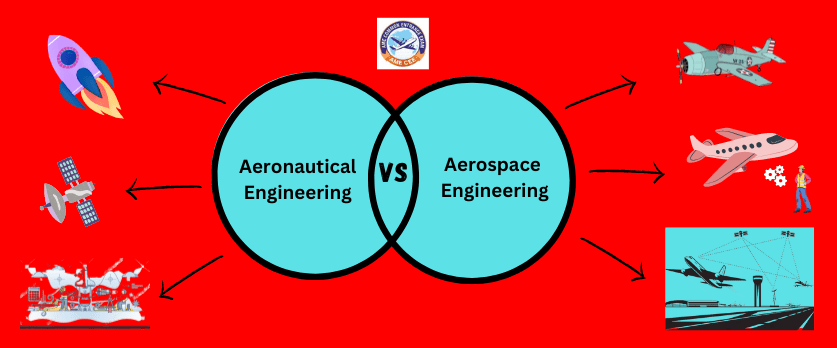The terms “aeronautical engineering” and “aerospace engineering” are related but refer to distinct fields within the broader realm of aerospace sciences. Here are the differences between these two engineering disciplines:
Definition
Aeronautical Engineering: This discipline focuses exclusively on the design, development, testing, and maintenance of aircraft intended for operation within the Earth’s atmosphere.
Aerospace Engineering: A more comprehensive field, aerospace engineering encompasses both aeronautical engineering (atmospheric flight) and astronautical engineering (space travel).
Scope
Aeronautical Engineering: Primarily concerned with flight technologies within Earth’s atmosphere, including airplanes, helicopters, and gliders.
Aerospace Engineering: Encompasses atmospheric flight as well as the design and development of spacecraft, satellites, and other vehicles intended for space exploration.
Applications
Aeronautical Engineering: Involves the study and improvement of technologies for vehicles navigating the Earth’s atmosphere.
Aerospace Engineering: Encompasses a broader range, extending from atmospheric flight to space travel, including satellites, spacecraft, and interplanetary exploration.
Skill Set
Aeronautical Engineering: Requires expertise in aerodynamics, propulsion, materials, and structures relevant to aircraft operating within Earth’s atmosphere.
Aerospace Engineering: Involves a similar skill set but may additionally require knowledge of space-related challenges, such as orbital mechanics and celestial navigation.
Collaboration
Aeronautical and Aerospace Engineering: While distinct, these fields often collaborate on projects, especially as technology advancements lead to the convergence of atmospheric and space technologies.
Career Opportunities
Aeronautical Engineering: Offers opportunities in designing and improving airplanes, helicopters, and related atmospheric vehicles.
Aerospace Engineering: Provides a broader spectrum of career paths, including involvement in spacecraft design, satellite systems, and contributions to space exploration.
In summary, aeronautical engineering specifically addresses flight within Earth’s atmosphere, while aerospace engineering embraces a more extensive scope, incorporating both atmospheric flight and the challenges of space exploration. These distinctions become increasingly significant as technological advancements continue to shape the future of aerospace sciences.
Aeronautical Engineering vs. Aerospace Engineering: 10 FAQs to Clarify the Distinctions
Q1. Are aeronautical engineering and aerospace engineering the same thing?
A. No, while related, they are not identical. Aeronautical engineering focuses on aircraft operating within Earth’s atmosphere, while aerospace engineering encompasses both atmospheric and spaceflight.
Q2. What is the primary focus of aeronautical engineering?
A. Aeronautical engineering is primarily concerned with the design, development, and maintenance of aircraft for flight within Earth’s atmosphere.
Q3. How does aerospace engineering differ from aeronautical engineering?
A. Aerospace engineering is a broader field that includes aeronautical engineering but extends to the design and development of spacecraft and vehicles for space exploration.
Q4. Can you provide examples of vehicles covered by aeronautical engineering?
A. Aeronautical engineering includes airplanes, helicopters, gliders, and other vehicles designed for flight within the Earth’s atmosphere.
Q5. What falls under the scope of aerospace engineering?
A. Aerospace engineering encompasses aeronautical engineering but also includes the design and development of spacecraft, satellites, and other vehicles intended for travel beyond Earth’s atmosphere.
Q6. Do aeronautical engineers work on spacecraft?
A. Generally, aeronautical engineers focus on atmospheric vehicles. However, as technology advances, there can be overlap, and some aeronautical engineers may work on spacecraft or collaborate with aerospace engineers.
Q7. Can aerospace engineers work on airplanes?
A. Yes, aerospace engineers can work on airplanes, as the field includes aeronautical engineering. They may be involved in designing various aerospace vehicles, from airplanes to spacecraft.
Q8. Is there a difference in the skill set required for aeronautical vs. aerospace engineering?
A. While there is overlap, aerospace engineering may require additional knowledge of space-related challenges. Both fields require expertise in aerodynamics, materials, propulsion, and other related areas.
Q9. Do aeronautical and aerospace engineers collaborate on projects?
A. Yes, collaboration is common. Projects often involve multidisciplinary teams where aeronautical and aerospace engineers work together to address challenges in both atmospheric and space environments.
Q10. How do advancements in technology impact these fields?
A. Technological advancements influence both fields by enabling more sophisticated designs, materials, and propulsion systems for aircraft and spacecraft. As technology progresses, the lines between aeronautical and aerospace engineering may blur further.
To become an aerospace engineer you may could join aerospace engineering through AME COMMON ENTRANCE EXAM (AME CEE) this examination you may join Aerospace Engineering approved by AICTE.


